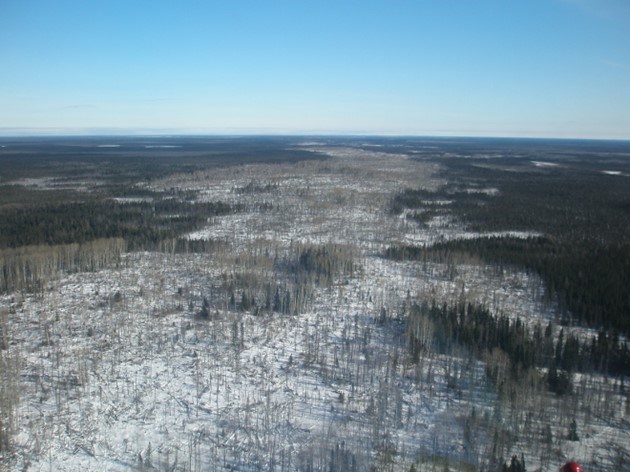TORONTO — The provincial government is throwing its support behind a north-south link to the Ring of Fire mineral zone in northwestern Ontario.
But its plan is already under sharp criticism from one First Nation, which insists there can be no construction without its permission.
Premier Doug Ford and Northern Development and Mines Ministers Greg Rickford on Monday announced a partnership to develop the road project with Marten Falls and Webequie First Nations.
They held a signing ceremony at the Prospectors and Developers Association of Canada convention with Marten Falls Chief Bruce Achneepineskum and Webequie Chief Cornelius Wabasse
The Northern Road Link, the leaders said in a statement, would link two other proposed roads – the 200- kilometre. Marten Falls-to-Aroland Community Access Road at the south end, and the proposed 110-kilometre. Webequie Supply Road to the Ring of Fire at the north end.
Both those projects are currently under environmental assessment.
The government announcement stated that it's delivering on its promise to move forward with the development of the Ring of Fire "with willing partners."
"After 15 years of delay by the previous government, we said we would build a road to the Ring of Fire, and we are working with our partners to do just that and make sure we do it right," Premier Ford said.
In addition to opening the mineral zone to development, the government said the road would improve access to health and social services and provide infrastructure such as high-speed internet and reliable cellular service to numerous First Nations communities.
Achneepineskum said "We are moving ahead with this agreement so all communities in the region can connect to the next phase, which is to secure and bring good-paying jobs in mining, construction and other skilled trades."
Wabassse said "We understand that road development will impact our traditional territories but believe this is a positive step forward to unlocking new opportunities that will benefit all surrounding First Nation communities."
The agreement outlines Ontario's support for the First Nations to advance the environmental assessments for their respective road projects, and to initiate planning and development of the Northern Road Link.
However, no timetable was provided in the announcement.
Neskantaga warns that its consent is required
There was an immediate response from Neskantaga First Nation, which warned that the Northern Road Link will be met with determined opposition from the community.
Chief Chris Moonias said "You can expect opposition if Ontario, or any road proponent, tries to put a shovel in the ground of our territory without our consent."
In a statement, Neskantaga said the proposed road would bisect the core of its territory and cross the Attawapiskat River, which it described as the lifeblood of its culture and way of life.
Moonias called the Ring of Fire a symbol of Ford's "jump on a bulldozer" agenda.
He said if the province wants to build a road, it will have to ensure "it doesn't become another flashpoint in broader national clashes between governments and First Nations on free, prior and informed consent."
Moonias complained that he only learned of Monday's announcement in a last-minute phone call from Rickford.
Earlier Monday, three other First Nations and the Town of Sioux Lookout sent representatives to Toronto to continue their advocacy for consideration of an east-west road to the Ring of Fire.
At a news conference at the legislature, the East-West Ring of Fire Road Coalition called for an examination of all options, including a road to the east from Highway 599 in the Pickle Lake area.
The coalition includes the Lac Seul, Cat Lake, Slate Falls and Kitchenuhmaykoosib Inninuwug First Nations, Sioux Lookout, the Sioux Lookout Friendship Accord, and private companies Perron Contracting and Morgan Fuels.
They said they support the recent federal government decision to conduct an expanded regional impact assessment of development in the Ring of Fire.
The government announced last month that it was agreeing to requests from Aroland First Nation, the Wildlife Conservation Society Canada, and Osgoode Hall Law School's Environmental Justice and Sustainability Clinic.
The review will be conducted under the terms of the new federal Impact Assessment Act, which came into force last year as a replacement for the Canadian Environmental Assessment Act.
"We are pleased to see the announcement of the federal Regional EA process, and are here today to remind both senior levels of government of the importance of considering all routes," Sioux Lookout Mayor Doug Lawrance said Monday.
Lawrance said "The stakes are high. Planning and development of access to Ontario's Far North is a complex undertaking. All options need to be considered with care."
Cat Lake Chief Matthew Keewaykapow said an east-west link will provide benefits to many remote communities, such as his.
"It is important for health care for the elders and the economic and education opportunities for youth," Keewaykapow said, adding that climate change has made the winter road network less and less reliable every year.
Businessman Darrel Morgan of Morgan Fuels described how crucial supplies such as food, fuel and construction materials currently "flow from the west to serve the area, often on winter ice roads."
Morgan said rail, road connections to the Trans-Canada Highway and air service can all be accessed via an east-west alignment, noting that the Sioux Lookout airport serves as a hub for 31 First Nations.
The federal government has stated the proposed Webequie Supply Road could become part of a future all-season road network connecting Webequie and the Ring of Fire area to the provincial highway system "at Nakina and/or at Pickle Lake."
A spokesperson for the provincial ministry of Energy, Northern Development and Mines told Tbnewswatch that Ontario "is interested in discussing with the federal government the potential scope and timelines of the regional assessment, how existing data collected in the Ring of Fire may help to inform and scope the process, and coordination with the ongoing community road assessments."
